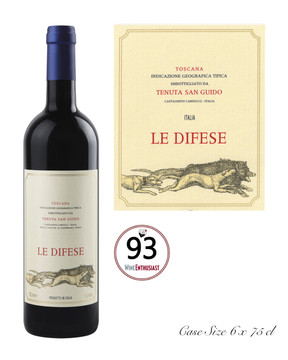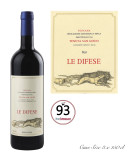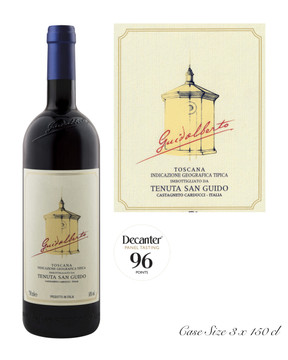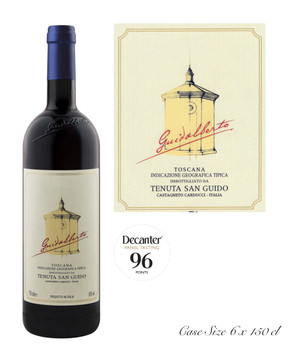
Tenuta San Guido Le Difese Magnum 2022.
The name Le Difese comes from the large lower canine teeth that local wild boars use to defend from attackers. Fruit for Le Difese is selected from Tenuta San Guido estate’s younger vines.
HARVEST NOTE: The 2022 was tendentially warm, although in Bolgheri and especially in the hills the situation was different compared to other areas of Italy and Tuscany itself. The autumn climate, until the first ten days of November, was somewhat bizarre with temperatures above the norm and abundant rains. Temperatures dropped significantly from the end of November and to December. In November the night temperatures often dropped below 0°C, creating an optimal situation for the vegetative rest of the plants and for the natural elimination of the vine parasites.
From the end of December, temperatures tended to rise again and, for some days, even above the norm. The rains continued in January and mid-February, the month in which cold temperatures close to 0°C returned, albeit for a few days. From the end of February temperatures tended to rise rapidly which created conditions of high humidity. From the last week of February until the end of March, we witnessed an unusual climatic situation with excessively mild temperatures and no rain. A situation which, especially in the lower areas of the estate, has anticipated the enlargement of the gems. In the very first days of April, a sudden drop in temperature caused a modest bud selection in some vineyards of early ripening varieties.
The remaining part of April was characterized by sunny days and windy days (especially the north wind) and temperatures slightly below the seasonal average. May began with mild temperatures and some sporadic rains, but from May 15th, the temperatures suddenly increased, going well beyond the seasonal average, both during the day and at night with the arrival of sultry heat. A climatic situation that was not helpful for the plants in the delicate moment of flowering and fruit setting, leading to a selection and consequent reduction in production. The summer was characterized by temperatures often above the seasonal norm and no rain, but fortunately the area and its pedoclimatic characteristics greatly helped. The proximity to the sea, the strong winds and the temperature range between night and day had a completely positive effect, allowing for a good quality vintage. There was also a clear gap between what happened in the hills compared to the plains, where obviously the situation was more difficult due to both the type of landscape and the lesser availability of shade and refreshment that the Mediterranean forest brings to the vineyards on the hills. The climatic conditions that occurred in the various seasons and influenced the various phenological phases of the vine and, although quality of the grapes was good, caused a lower production of around -27%.
However, the lower production per plant and the sparser bunches helped the plants to maintain the production and complete ripening while avoiding stressful conditions. The intense heat lasted until mid-August, when a perturbation brought the arrival of rains and a drop in temperature. The 2022 was certainly not an easy vintage or even a generous one in terms of quantity, but in terms of grape quality (especially those from hillside vineyards), it recorded clearly positive results. A vintage in which it was still possible to maintain an excellent balance in terms of total acidity but also a moderate alcohol content thanks to faster harvesting operations. The maceration of the grapes was reduced in order to avoid an extraction of less noble tannins and the development of astringent notes of the musts. Le Difese 2022 shows a nice intensity of fruit, soft and well-integrated tannins.
HARVEST PERIOD: The harvest, carried out by hand, began on 4 September for the Cabernet Sauvignon grapes and from 16 September with the Sangiovese, to end at the end of the month. It was necessary to speed up the harvest to prevent the grapes, perfectly ripe and of good quality, from risking excessive progress in the technical maturation. We worked during the coolest hours of the day and at night (especially in the cellar) to allow the grapes to be kept at optimal temperatures for their processing. This has made it possible to achieve the correct qualitative objectives of the musts.
WINEMAKING NOTES: Accurate selection and sorting by hand of the bunches during the hand harvest. Subsequent selection upon arrival of the grapes in the cellar via a sorting table. Very soft crushing-destemming of the grapes to avoid improper transfer of tannins. Primary fermentation in stainless steel vats at controlled temperature (26-27°C). Maceration on the skins for 12-14 days for the Cabernet S. and for about 11-12 days for the Sangiovese, with frequent pumping over to oxygenate and lower the temperature of the musts. We have reduced the délestage operations to avoid excessive tannic transfer. Malolactic fermentation carried out in steel and concluded at the end of November.
REFINEMENT: At the end of the malolactic fermentation, the wine was fined in French oak barriques, previously used for Guidalberto. Subsequent conservation in steel vats at a controlled temperature of 3-4°C to confer tartaric stability before bottling.
The name Le Difese comes from the large lower canine teeth that local wild boars use to defend from attackers. Fruit for Le Difese is selected from Tenuta San Guido estate’s younger vines.
HARVEST NOTE: The 2022 was tendentially warm, although in Bolgheri and especially in the hills the situation was different compared to other areas of Italy and Tuscany itself. The autumn climate, until the first ten days of November, was somewhat bizarre with temperatures above the norm and abundant rains. Temperatures dropped significantly from the end of November and to December. In November the night temperatures often dropped below 0°C, creating an optimal situation for the vegetative rest of the plants and for the natural elimination of the vine parasites.
From the end of December, temperatures tended to rise again and, for some days, even above the norm. The rains continued in January and mid-February, the month in which cold temperatures close to 0°C returned, albeit for a few days. From the end of February temperatures tended to rise rapidly which created conditions of high humidity. From the last week of February until the end of March, we witnessed an unusual climatic situation with excessively mild temperatures and no rain. A situation which, especially in the lower areas of the estate, has anticipated the enlargement of the gems. In the very first days of April, a sudden drop in temperature caused a modest bud selection in some vineyards of early ripening varieties.
The remaining part of April was characterized by sunny days and windy days (especially the north wind) and temperatures slightly below the seasonal average. May began with mild temperatures and some sporadic rains, but from May 15th, the temperatures suddenly increased, going well beyond the seasonal average, both during the day and at night with the arrival of sultry heat. A climatic situation that was not helpful for the plants in the delicate moment of flowering and fruit setting, leading to a selection and consequent reduction in production. The summer was characterized by temperatures often above the seasonal norm and no rain, but fortunately the area and its pedoclimatic characteristics greatly helped. The proximity to the sea, the strong winds and the temperature range between night and day had a completely positive effect, allowing for a good quality vintage. There was also a clear gap between what happened in the hills compared to the plains, where obviously the situation was more difficult due to both the type of landscape and the lesser availability of shade and refreshment that the Mediterranean forest brings to the vineyards on the hills. The climatic conditions that occurred in the various seasons and influenced the various phenological phases of the vine and, although quality of the grapes was good, caused a lower production of around -27%.
However, the lower production per plant and the sparser bunches helped the plants to maintain the production and complete ripening while avoiding stressful conditions. The intense heat lasted until mid-August, when a perturbation brought the arrival of rains and a drop in temperature. The 2022 was certainly not an easy vintage or even a generous one in terms of quantity, but in terms of grape quality (especially those from hillside vineyards), it recorded clearly positive results. A vintage in which it was still possible to maintain an excellent balance in terms of total acidity but also a moderate alcohol content thanks to faster harvesting operations. The maceration of the grapes was reduced in order to avoid an extraction of less noble tannins and the development of astringent notes of the musts. Le Difese 2022 shows a nice intensity of fruit, soft and well-integrated tannins.
HARVEST PERIOD: The harvest, carried out by hand, began on 4 September for the Cabernet Sauvignon grapes and from 16 September with the Sangiovese, to end at the end of the month. It was necessary to speed up the harvest to prevent the grapes, perfectly ripe and of good quality, from risking excessive progress in the technical maturation. We worked during the coolest hours of the day and at night (especially in the cellar) to allow the grapes to be kept at optimal temperatures for their processing. This has made it possible to achieve the correct qualitative objectives of the musts.
WINEMAKING NOTES: Accurate selection and sorting by hand of the bunches during the hand harvest. Subsequent selection upon arrival of the grapes in the cellar via a sorting table. Very soft crushing-destemming of the grapes to avoid improper transfer of tannins. Primary fermentation in stainless steel vats at controlled temperature (26-27°C). Maceration on the skins for 12-14 days for the Cabernet S. and for about 11-12 days for the Sangiovese, with frequent pumping over to oxygenate and lower the temperature of the musts. We have reduced the délestage operations to avoid excessive tannic transfer. Malolactic fermentation carried out in steel and concluded at the end of November.
REFINEMENT: At the end of the malolactic fermentation, the wine was fined in French oak barriques, previously used for Guidalberto. Subsequent conservation in steel vats at a controlled temperature of 3-4°C to confer tartaric stability before bottling.







